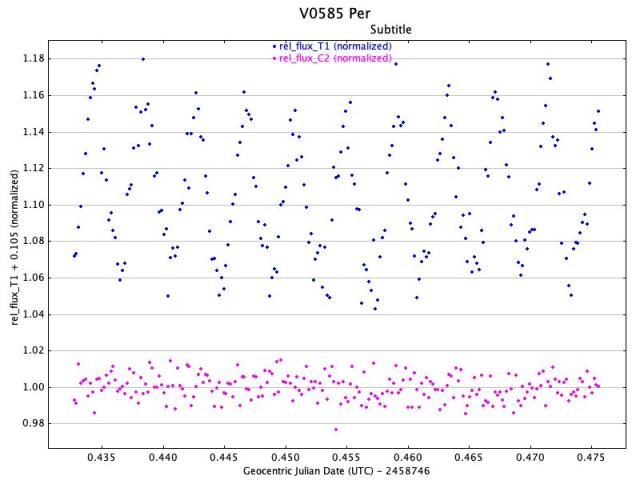› Forums › Variable Stars › Shortest Period Variable Star
- This topic has 6 replies, 3 voices, and was last updated 6 years, 3 months ago by
 Robin Leadbeater.
Robin Leadbeater.
-
AuthorPosts
-
23 September 2019 at 12:20 am #574407
 Eliot HallParticipant
Eliot HallParticipantSearching for a short period variable stars that I could observe I found V0585 Per that had a period of 5.9 minutes. Attached is a very rough and ready light curve from a couple of days ago. (I’m not sure if the secondary longer period change in brightness is real or caused by my imaging technique or a bad reference star).
But I was had wondered what is the shortest period variable star that is observable using amateur equipment visual or CCD?

Attachments:
23 September 2019 at 7:44 am #581390 Dr Paul LeylandParticipant
Dr Paul LeylandParticipantCM Tauri, at 33.5 milliseconds, is an obvious contender.
23 September 2019 at 7:50 am #581391 Eliot HallParticipant
Eliot HallParticipantI hadn’t considered radio. Would it be detectable by amateurs?
23 September 2019 at 8:27 am #581392 Dr Paul LeylandParticipant
Dr Paul LeylandParticipantThe optical variability is measurable by amateurs. I was paying attention to your “visual or CCD” request, honest!
See http://www.threehillsobservatory.co.uk/astro/astro_image_33.htm for instance, where Robin Leadbetter presents his images and http://www.threehillsobservatory.co.uk/astro/pulsar_detection_1.htm where the technique is described.
23 September 2019 at 8:46 pm #581393 Eliot HallParticipant
Eliot HallParticipantGreat project – Robin is a pioneer.
Taking inspiration Emil Kraaikamp deep sky images using CMOS cameras at fast(ish) frame rates using big scopes – I wonder if the chopper could be replaced with a CMOS camera. If the camera was run at 60Hz (twice as fast as the Crab’s pulse rate). All even numbered frames were stacked together and the same with odd numbered frames. Then the two images would be subtracted from each other. Only the light from the pulsar would remain – proving the pulse rate?
It would rely on a bit of luck with the timing – if the capture started at the maxima or minima there would be no difference in the pulsar’s brightness between the frames. Also I’m not sure you could trust the camera to run at a constant speed and not drop frames whilst capturing. Finally whilst the read noise very low on CMOS chips I’m not sure there would be enough flux to overcome it.
With all this thinking I might need a lie down…
23 September 2019 at 11:21 pm #581394 Robin LeadbeaterParticipant
Robin LeadbeaterParticipantI know it is possible directly with a 1m scope and an EMCCD based camera which has effectively zero read noise
https://www.cloudynights.com/topic/285383-crab-nebulass-pulsar-is-blinking-not-a-joke/?p=3632352
but it might be interesting to run the figures for a modern CMOS camera to see if given a reasonable size scope, summing enough images at each phase could pull the signal out
Robin
24 September 2019 at 11:08 am #581395 Robin LeadbeaterParticipant
Robin LeadbeaterParticipant>It would rely on a bit of luck with the timing – if the capture started at the maxima or minima there would be no difference in the pulsar’s brightness between the frames. Also I’m not sure you could trust the camera to run at a constant speed and not drop frames whilst capturing.
I think provided the exposure time is short enough (less than the max to min), the frame rate just needs to be known and stable (and just different from, even slower, than the pulsar). You can then assign a relative phase to each frame and stack the frames in groups with similar phase. A quick initial test would be to test if the pulsar can be seen in a simple stack of short enough exposures. If so then seeing the pulses should just be a matter of picking the right ones out and stacking them. In theory I suspect you could even find the pulsations without knowing the period.
-
AuthorPosts
- You must be logged in to reply to this topic.
